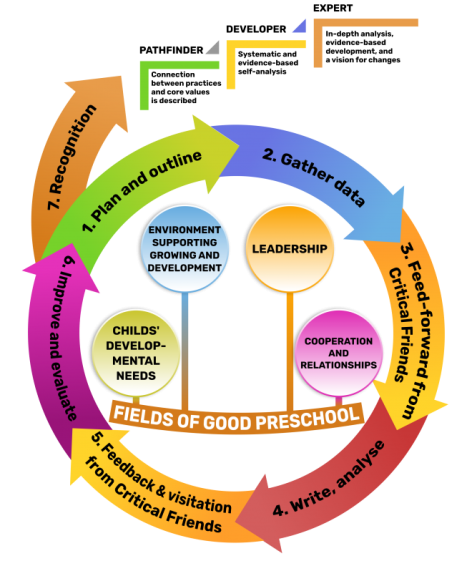Good Preschool Model
The Good Preschool model comprises four areas of school life. The aspects have been divided into four areas and the division is based on the internal evaluation report of Estonian preschools.
Image

CHILDS' DEVELOPMENTAL NEEDS
- The developmental needs of each child are ascertained and taken into account in the teaching and education work
- Children are helped to make connections between new knowledge and earlier experiences
- Methods and tasks that foster discovery and experimenting are used
- Teaching and education work is analysed and evaluated
- The teaching and education process is based on play
- Children are taught to be independent
- Emphasis is placed on the development of social skills (including communication, expression and discussion skills)
- Creativity, initiative, and sense of responsibility are developed in children
- Thinking and problem-solving skills are developed in children
- The children are taught to be considerate and respect themselves, their parents, other children, fellow citizens, and all living beings
- The children are allowed uninterrupted playtime
- The development of each child is monitored and evaluated
- Children and their parents receive feedback on the child’s development
- There is an established recognition procedure that is known to all preschool members
- The preschool has functioning support systems (e.g. a speech therapist, special education teacher, psychological and social-educational counselling)
- The preschool has developed its own traditions and these traditions are deemed important
ENVIRONMENT FOR GROWTH AND DEVELOPMENT
- The children and teachers enjoy being in the preschool and it brings them joy
- Members of the preschool are united by a feeling of ownership over their preschool
- The children are cared about, and their feelings and opinions are taken into account
- The children are involved in shaping their environment and establishment of rules
- The environment offers opportunities for diverse play and children can do activities in smaller groups
- The learning and growth environment of the preschool is safe and healthy with no excessive stress (days are not over-planned)
- Play and learning tools that are appropriate to the age and stage of development of the children are used
- The management receives information about problems and they are actively solved and prevented
- Healthy lifestyle is promoted (including concentrating on healthy eating, hygiene, spending time outside)
- The peculiarities (including nutritional peculiarities) and special needs of children are taken into account
LEADERSHIP
- Goals are consciously set in the preschool (established goals and a plan to achieve them) and they are taken into account in everyday activities
- Values are developed systemically and consistently
- The preschool staff receives meaningful feedback to their work
- The management is open, inspiring, inclusive and fair and the head of preschool is a good role model for the entire preschool
- The preschool staff is professional, development-oriented and engages in self-reflection
- The head of preschool motivates the preschool staff and supports their development
- The staff is aware of what is going on in the preschool and knows the bases of decisions
- Resources (time of the staff and children, funds, rooms, etc.) are effectively used to achieve the best result
- Different parties are involved in planning the efficient use of resources
COOPERATION AND RELATIONSHIPS
- Different members of the preschool cooperate: there is effective cooperation between teachers and teachers, teachers and children, children and children, parents and teachers, teachers and management, parents and support staff, teachers and support staff, and preschool and the community. Various forms of cooperation are used
- The preschool cooperates with other preschools or institutions to share their experiences, troubles and joys
- Self-development and the habit of cooperating with the preschool are supported in parents, and families have opportunities to learn from one other
- Children, teachers and other preschool staff members and parents manage and/or are involved in various preschool projects
- Different parties of the preschool are engaged in preventing and solving conflicts
- All parties who need help receive it


